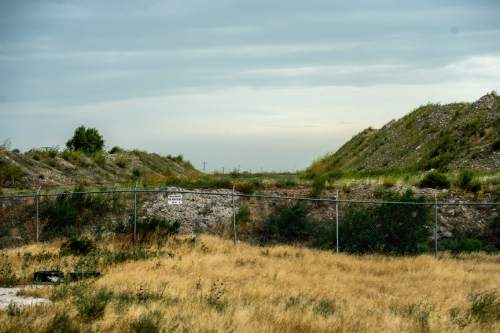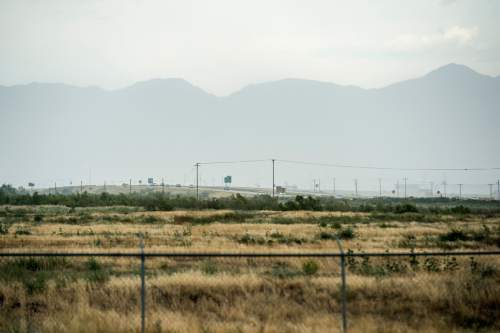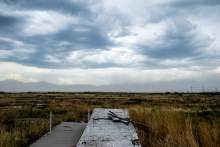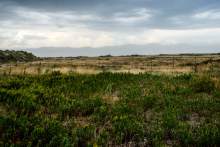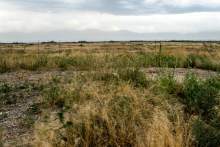This is an archived article that was published on sltrib.com in 2015, and information in the article may be outdated. It is provided only for personal research purposes and may not be reprinted.
The state may move the prison to Salt Lake City, but that doesn't end the debate over where to put it.
That's because members of the Prison Relocation Commission last week unanimously selected a sprawling 4,000-acre parcel between Salt Lake City International Airport and the Great Salt Lake. Only 500 acres is needed for the prison complex, and the commission didn't determine exactly where to build on this tricky piece of undeveloped brush dotted with wetlands, threatened bird species and soft soil, which, at spots, is more than 10 stories deep.
That selection is left to the real-estate and construction experts in the administration of Gov. Gary Herbert and they say it will take months to make the call.
"This is not going to happen quickly," said Bruce Whittington, interim director of the Division of Facilities Construction and Management. "I don't see us closing on the property for a long time."
That's true even if the Legislature approves the move in a special session Wednesday and Salt Lake City's leaders back off of their threats to sue.
Essentially, the state is considering two spots on the larger parcel — one to the east and one to the west — that pose different obstacles and opportunities. The one that has received the most attention is the east site primarily owned by Rio Tinto, the international conglomerate that oversees the Kennecott copper mine. This land sits just north of a now-defunct landfill and is close to the 7200 West interchange on Interstate 80. It's near existing gas, electricity and water lines.
Bob Nardi, the consultant to the commission, says the state can build a prison and bypass the landfill entirely, but the city warns that disrupting the buried garbage could taint water supplies and would need to be remediated.
The west location is about 1.5 miles closer to the Great Salt Lake and is owned by members of the Pedroncelli family, who operate a winery in California's Sonoma Valley. On the plus side, extending utilities closer to the lake would make it easier to develop the rest of this area. But this more-remote site sits at a lower elevation, and that could be a big problem. Any construction below 4,217 feet could be covered in water if the lake rises in the coming decades. Parts of this site are at 4,215 feet, meaning crews would have to bring in enough fill — Nardi put the estimate at 2.2 million tons — to raise the site above the flood plain.
Both sites are on soft ground that would take at least a year and a half to prepare for construction, a problem made even more difficult because the land is near two fault lines. Earthquakes and soft soil can lead to liquefaction, particularly in such wet areas, which can cause the ground to act like quicksand and everything, even buildings, can sink.
Both sites may have wetlands and sensitive bird habitats, such as those used by burrowing owls, that need to be avoided or mitigated (those studies are ongoing).
These are the reasons Nardi said the Salt Lake City locations would be the hardest to build on and cost more than the now-rejected finalists in Grantsville, Eagle Mountain and Fairfield.
But none of these issues is a deal-breaker. Not yet.
"There is definitely buildable space out there," Whittington said. His team will continue the studies, while preparing purchase agreements for the east and west sites. Once a location is selected, some team members will work on foundation problems, while others will start designing the prison complex, a series of buildings expected to cover about 360 acres.
The state commission favored the Salt Lake City location because it is much closer to the major metro area, hospitals, courthouses and the existing volunteer base.
Nardi and his team have studied the area since December and may play an ongoing role in the assessment, although that has yet to be determined. He has worked not only on technical issues, but he's also participated in some of the politically sensitive conversations with environmental groups and city leaders.
He led a meeting Monday, the day before the commission picked Salt Lake City, with members of the Great Salt Lake Alliance. Among the concerns discussed were the migratory birds that frequent the area. Nardi promised the alliance that a modern prison complex would have only two-story buildings, because corrections employees want to avoid elevators for security reasons. The structure would be made mostly of concrete and would have few windows. Shorter buildings with less reflective glass should mean fewer dead or injured birds.
He also said the state would try to comply with a planned conservation zone environmental groups are working on with Salt Lake City leaders.
"The state wants to be flexible and work with the environmental organizations, because there are a lot of them," Nardi said. "We don't want it to be adversarial."
State leaders are well aware of how an environmental lawsuit, focused on either the wetlands or the landfill, could drag out this project. And they know that Salt Lake City Mayor Ralph Becker, the City Council and state lawmakers who represent the area are hunting for ways to quash the prison move — a state project that hit a major milestone with the Prison Relocation Commission's decision, but still has a long way to go.
mcanham @sltrib.com #
A penitentiary in Salt Lake City
The Prison Relocation Commission unanimously voted to build a prison west of the Salt Lake City International Airport, a decision that now needs to be approved by the Legislature and Gov. Gary Herbert. Here are some of the unique issues that must be addressed:
Land costs • The state expects to pay about $30 million for roughly 500 acres to either Rio Tinto or the Pedroncelli family, depending on exactly where the prison is placed.
Elevation • The land may need to be artificially raised to avoid a flood if the Great Salt Lake's water level rises in coming years. It could take as much as 2.2 million tons of fill.
Wetlands and conservation • The Army Corps of Engineers has yet to sign off on the wetland survey of the land. It could be costly to mitigate wetlands on the site. The state is interested in working to maintain a conservation zone near the Great Salt Lake.
Bugs • The area is infested with mosquitoes and consultants expect the state to spend $160,000 a year fighting them.
Landfill • An old landfill in the area is a complicating factor. The garbage could taint the groundwater and make it difficult to build a road to a new prison. So far, there's been no study of how much it would cost to clean up the area.





